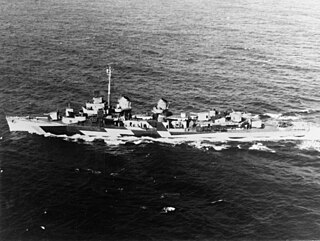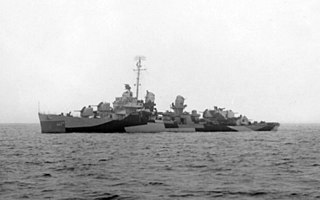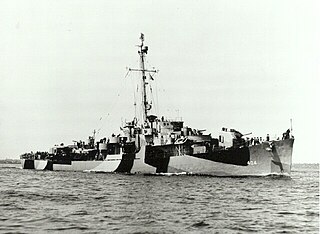
USS Franks (DD-554), a World War II-era Fletcher-class destroyer in the service of the United States Navy, was named after Medal of Honor recipient Acting Master's Mate William Joseph Franks.

USS Dennis (DE-405) was a John C. Butler-class destroyer escort in the service with the United States Navy from 1944 to 1946. She was scrapped in 1973.

USS John C. Butler (DE-339) was the lead ship of her class of destroyer escorts in the service with the United States Navy from 1944 to 1946. She was recommissioned between 1950 and 1957 and finally sunk as a target in 1971.

USS Helm (DD-388) was a Bagley-class destroyer in the United States Navy during World War II. She was named for Rear Admiral James Meredith Helm. Helm received 11 battle stars for her World War II service in the Pacific.

USS Stembel (DD-644) was a Fletcher-class destroyer in service with the United States Navy from 1942 to 1947 and from 1951 to 1958. In 1961, she was transferred to Argentina where she served as ARA Rosales (D-22). She was scrapped in 1982.

USS Richard W. Suesens (DE-342) was a John C. Butler-class destroyer escort in service with the United States Navy from 1944 to 1947. She was finally sold for scrap in 1973.

USS O'Flaherty (DE-340) was a John C. Butler-class destroyer escort built for the United States Navy during World War II. She was named for Ensign Frank Woodrow O'Flaherty, a pilot who posthumously received the Navy Cross for his actions at the Battle of Midway.

USS Halligan (DD-584) was a Fletcher-class destroyer of the United States Navy, named for Rear Admiral John Halligan, Jr. (1876–1934).

USS Hale (DD-642), a Fletcher-class destroyer, was the second ship of the United States Navy to be named for Maine Senator Eugene Hale (1836–1918).

USS Twiggs (DD-591), a Fletcher-class destroyer, was the second ship of the United States Navy to be named for Marine Major Levi Twiggs (1793–1847).

USS Sigsbee (DD-502), a Fletcher-class destroyer, was a ship of the United States Navy named for Rear Admiral Charles D. Sigsbee (1845–1923).

The third USS Macdonough (DD-351) was a Farragut-class destroyer in the United States Navy during World War II. She was named for Thomas Macdonough.

USS Patterson (DD-392), a Bagley-class destroyer, was the second ship of the United States Navy to be named for Daniel Todd Patterson, an officer of the US Navy who served in the Quasi-War with France, First Barbary War, and the War of 1812.

USS Conner (DD-582) was a Fletcher-class destroyer of the United States Navy, the second Navy ship to be named in honor of Commodore David Conner (1792–1856), who led U.S. Naval forces during the first part of the Mexican–American War.

USS Heywood L. Edwards (DD-663) was a Fletcher-class destroyer of the United States Navy, named after Lieutenant Commander Heywood L. Edwards (1905–1941), captain of the destroyer USS Reuben James, the first U.S. Navy ship sunk in World War II. Following the war, the ship was transferred to Japan and renamed Ariake. The ship served with the Japanese until 1974 and was scrapped in 1976.

USS Eversole (DE-404) was a John C. Butler-class destroyer escort built for the United States Navy during World War II. Named for Lieutenant John Thomas Eversole,, she was the first of two U.S. Naval vessels to bear the name. The vessel was torpedoed and sunk on 28 October 1944.

USS Wesson (DE-184) was a Cannon-class destroyer escort built for the United States Navy during World War II. She served in the Pacific Ocean and provided escort service against submarine and air attack for Navy vessels and convoys. She returned home at war's end with a very respectable seven battle stars to her credit.

USS Richard M. Rowell (DE-403) was a John C. Butler-class destroyer escort acquired by the United States Navy during World War II. The primary purpose of the destroyer escort was to escort and protect ships in convoy, in addition to other tasks as assigned, such as patrol or radar picket. During her career she earned six battle stars to her credit.

USS Edmonds (DE-406) was a John C. Butler-class destroyer escort in service with the United States Navy from 1944 to 1946 and from 1951 to 1965. She was scrapped in 1973.

USS Howard F. Clark (DE-533) was a John C. Butler-class destroyer escort in service with the United States Navy from 1944 to 1946. She was sold for scrapping in 1973.




















